Children are different!
Parents often tend to compare their children with others, and as soon as they notice such a “lag,” they begin to worry. The main mistake of these fathers and mothers is that they forget or ignore the fact that all children are different, the dynamics of their growth and development cannot be the same.
As a result, parents are in a hurry to “sit down” their baby, following the recommendations of one part of pediatricians. For example, they line it with pillows, propping it up so that the child sits without falling. It happens that mothers and fathers, noticing that the child is pulling his head to his chest, think that this is an attempt to sit up, lift him by the arms, rushing things a little.
Other children's doctors, on the contrary, do not advise doing this. They put forward as a fairly reasonable argument that at this age children usually master either crawling or sitting, and it is impossible to solve two completely different tasks at the same time. In addition, it has been noticed that many babies, having learned to crawl, begin to sit up on their own from a position on all fours. Therefore, when a baby is not sitting at 6 months, many experts encourage parents to be patient and take their time. Which one is right?
What do Americans have to do with it?
Mothers are obedient people. They said to be patient - they wait. But the abundance of all kinds of devices such as walkers, jumpers, car seats from 0+ will lead anyone into confusion. Why are they created then if they are “harmful”? The thing is that there are several approaches to the question of when to plant a baby.
American approach
Americans allow children to sit almost from birth. They are the main buyers of sun loungers, kangaroo carriers, baby sitters and other similar products.
Thematic material:
- Baby development by months to one year
- Gymnastics for newborns
Domestic approach
Komarovsky and other domestic doctors believe that it is correct to sit a baby no earlier than six months, so that the muscle corset is sufficiently strong. Otherwise, they endlessly repeat, scoliosis is guaranteed for the baby.
Natural Parenting Approach
This kind of “parenting” assumes that the baby should sit down independently when he wants to. It doesn’t matter if this happens at 3, 4 or 8 months. And he will sit down! Because mom and dad pay great attention to his physical development, regularly and correctly perform gymnastic exercises with him, and do not forget about massages.
The well-known pediatrician Komarovsky is also of the opinion that the main thing is the child’s desire to sit, but reminds us of the seriously increasing load on the spine in this position.
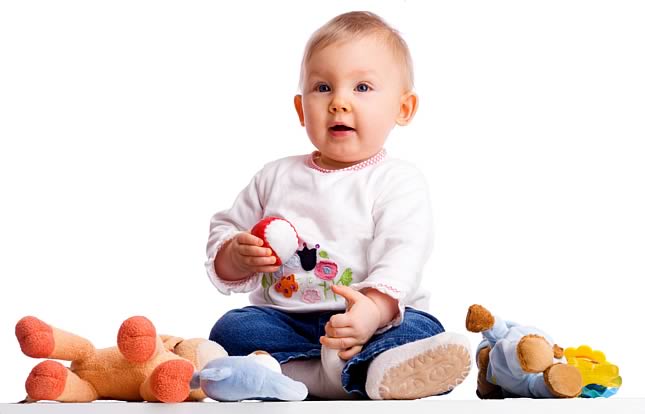
Don't rush your baby!
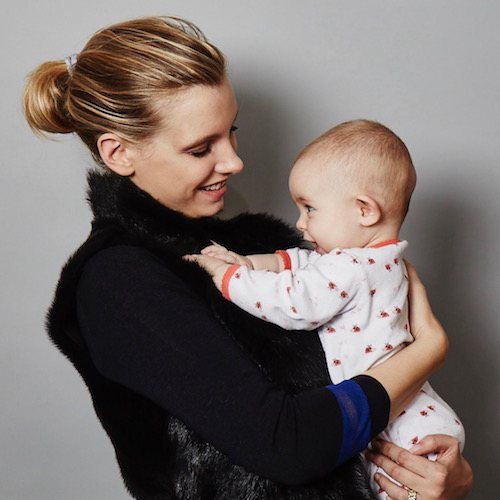
We can say that both are right in their own way. You just need a reasonable approach. This requires being careful and discerning. For parents whose child does not sit at 6 months, it is important to remember this principle: just as a plant grows on its own and it is impossible to pull it up, so the child’s ability to sit cannot be accelerated. If you sit down your baby when his body is not yet ready, then this can only cause harm. Is it worth it to provide assistance to “bear kangaroos”? They will also strain the child’s back excessively and will only bring harm. After all, if you sit down your baby, leaving him in a sitting position for a long time, this can lead to curvature of the spine due to unplanned load.
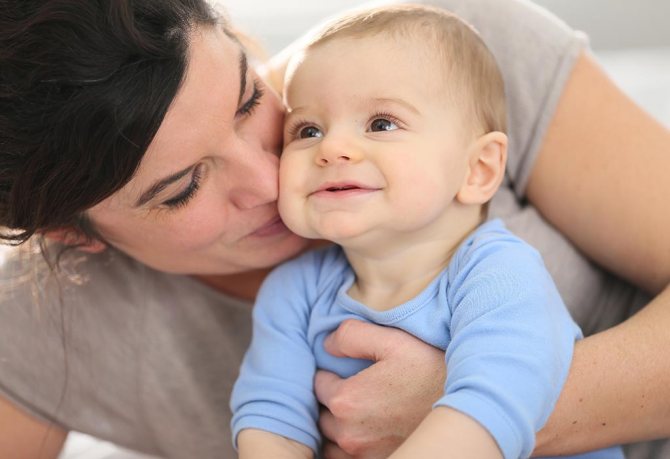
How to properly seat a girl?

Starting from 6 months of age, and after preliminary consultation with a pediatrician, you can safely begin to sit down the girl.
But even without consultation, attentive parents can understand that the child is ready to sit down.
And the following factors speak about this:
- the girl quite actively and effortlessly turns from back to stomach and back;
- the baby holds her head confidently and can independently lift it from a horizontal position;
- the girl begins to make attempts to get up on her own, while holding on to various objects or a parent.
When starting to sit the girl down, you should ensure that the child is comfortable first of all. At first, all children cannot maintain their balance, as a result of which they sit extremely unsteadily and often fall to one side. In this case, you shouldn’t worry and constantly correct them. As soon as the back and abdominal muscles get used to such loads, the girl will begin to sit straighter and more confidently.
Do not pile piles of pillows and piles of blankets around your child. Sitting in such cramped conditions will make the child uncomfortable and he will not be able to change position when he gets tired. These precautions will not be superfluous, but it is worth laying them in such a way that the child has free space for maneuvers.

Mom sits her daughter down
Sometimes it happens that the baby is unable to sit in the correct position. In such cases, the main thing is not to force the girl to take a position that is uncomfortable for her. In such a situation, you should pay attention to special gymnastic exercises to strengthen the back muscles:
- The girl must be placed on her stomach so that her legs rest against the adult’s body. The child must be lifted, holding it with one hand under the shin and the other under the chest. In this case, the gluteal and back muscles should be tense. You should try to hold the baby in an elevated position for a few seconds, and then carefully lay him back on his stomach.
- During daily air baths, the girl should be laid on her stomach, and at the same time a bright object should be placed in front of her, to which she wants to reach. In this way, the abdominal and back muscles are perfectly strengthened, which will help prepare her for mastering the “sitting” position. Similar to this exercise, you can attach bright round hoops above the crib. The girl will try to grab onto them, and if she is successful, she will try to get into a sitting position on her own.
- The girl needs to be laid on her back and the index fingers extended towards her. When she grabs them, she makes an attempt to sit up. At the same time, the girl’s back will come off the surface, and the abdominal muscles will tense. The main thing in this exercise is to try to hold the child in this position for 20 seconds, after which it is necessary to return the child to the starting position.
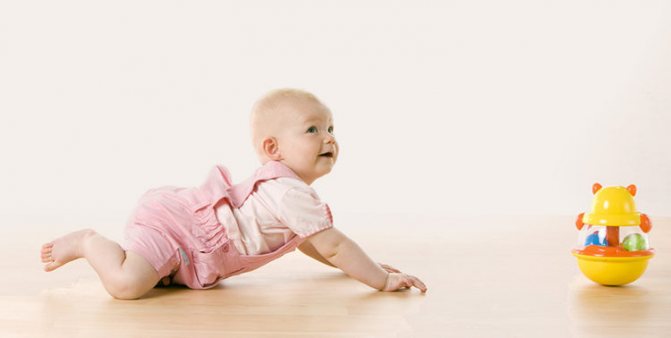
Child crawls for a toy
These exercises can and should be performed daily. Don't worry if your child can't master this position right away. Some children need more time, although in these relationships it is best to rely on set deadlines:
- starting from 6 months, the girl sits with the support of an adult;
- from 7 months the child is able to sit without additional support;
- from 8 months the girl can independently take a sitting position and even lie down from it.
All exercises must be carried out with the approval of a pediatrician and strictly on a hard surface.
Specialist help and exercises
It is important to find out the reason why a child does not sit at 6 months. To do this, it is best to consult a therapist. He may recommend special exercises to strengthen the child's back muscles. However, if you look closely at the baby’s movements, you will notice that he tends to spin, turning over from his back to his tummy and vice versa.
Also, when lying on its side, the child tries to lift the body. With these body movements, the child trains his back and other body muscles that help him sit. Indeed, the fact that a child does not sit at 6 months does not mean that he will never learn to do so. And it is not at all necessary that this happen at the same time as other children. The main thing is to carefully help your baby in this training, and a specialist will tell you how best to do it.

Sits or sits down
When assessing a baby's ability to sit, parents are often confused about these concepts. Therefore, they begin to worry and rush, and forcefully place the child ahead of schedule.
Similar material:
- When do children begin to sit on their own?
- How to teach a child to crawl on his belly
By six months, babies are sitting with support or support, but it is difficult to maintain this position; they constantly fall forward or on their side.
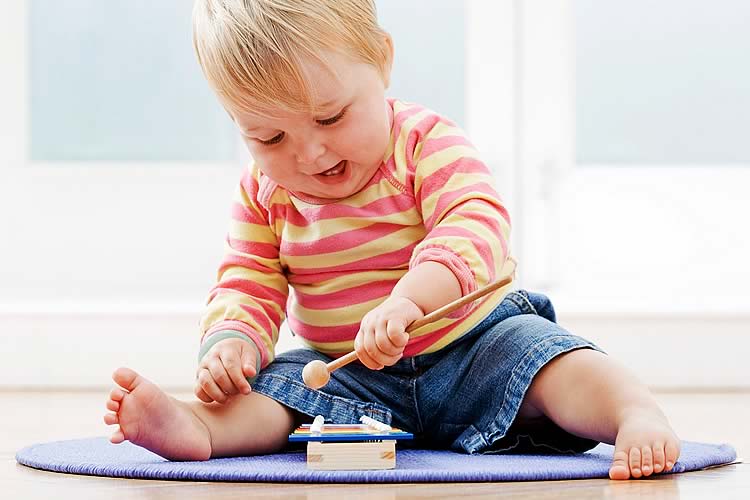
At this stage, in short attempts to sit, the back muscles are strengthened, and the baby himself learns to balance in this position.
Closer to 7 months, the baby will be able to sit independently, although not for long. But it will “sit down” even later. When a child learns to crawl, he will sit up from a “lying” position, “on all fours.” It is the ability that sits down on its own and will be the final stage in the formation of the skill. At what age? Most often at 8-9 months.
If by this time the baby does not even make attempts, contact a specialist (neurologist or orthopedist).
When to see a doctor?
Of course, the attitude will be completely different if a child cannot sit by 8 months due to delayed psychomotor development. Then parents should immediately contact a neurologist. The following reasons could lead to the inability to sit at this age:
- early birth;
- hypoxia;
- anemia during pregnancy;
- fetal prematurity;
- intracranial pressure.
To summarize, we can say that if parents suddenly notice that the child is not sitting at 6 months, there is no need to sound the alarm. They can provide systematic assistance to the baby so that he can gradually learn to sit. In this case, this will be a natural and safe stage of development for the child.
What should a baby be able to do at six months?
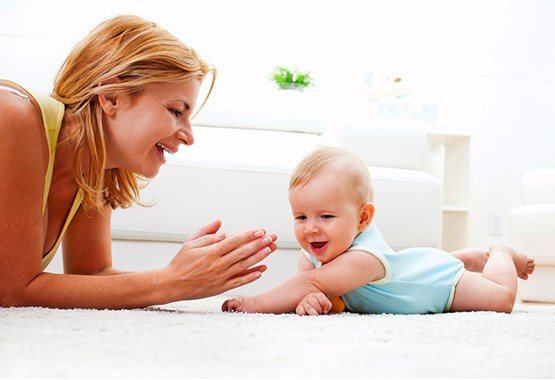
A six-month-old baby is improving some old skills, and he can also do a lot of things that he couldn’t do before. It is important to notice his new abilities and strive to help the baby develop them.
Everything that a child should be able to do at 6 months can be divided into two areas of development:
- speech skills, expression of emotions and communication;
- skills related to body movements.
It's worth looking at this in more detail.

Communication skills and expression of emotions
A six-month-old baby already responds when he hears his name. He can also repeat some sounds he hears and “return” emotions. At this age, the child already understands some simple words, for example, “you can’t,” “eat,” “let’s go,” especially if the parents complement what was said with appropriate gestures.
And although the baby does not yet understand many words, the child is already able to store in his memory what he hears. This will play a role in his speech abilities in six months or a year. Musical recordings, songs and poems have a developmental effect. A child at six months old learns everything perfectly. The emotions he shows become more varied. Before this age, the state usually changed from “I’m happy” to “I’m crying.” Now a new palette of emotions has been added:
- discontent;
- sadness;
- pleasure;
- fear;
- wariness.
At this age, the sounds with which the baby calls to be picked up, looked at, or expresses his delight at something also become varied.
Body movement skills

At 6 months, the child’s muscle hypertonicity decreases, and it is easier for him to perform many body movements. For example, he can already roll over from his back to his tummy and in the opposite direction. Lying on his stomach, the baby can lean on one hand and take an object of interest with the other. Firmly grasping, for example, the fingers of an adult, a child, lying on his back, strives to pull himself up. Attempts to crawl become independent.
Starting from six months, the child, if he is not yet sitting, is actively trying to do so. If you support the baby by the armpits, he can firmly push off the surface with his legs. The child shows great interest in all kinds of objects, trying to pick them up, try them out, and throw them on the floor. The child is able to take a toy in each hand at the same time.
A six-month-old child, holding the edge of the crib with his hands, learns to stand without the help of others. If you hide an object under a blanket, the baby is able to find it and knows how to get it out of there.
Many parents have noted that, starting from 6 months, the child can play independently for a long time, about 15 minutes (this is a lot for this age). What can a child do with passion? For example, play activities such as putting small objects into a box or putting on the rings of a pyramid are quite within the capabilities of a 6-month-old child.
What does it mean to "sit down"
Let's start with the age at which a skill is formed. Physiologically, a child’s spine is ready for this by 6–9 months. Before this, sit the child down - i.e. It is not recommended to artificially impart a sitting position. Why it’s not possible or how early sitting is dangerous for children’s health can be found in the article “At what months do girls sit down.”
But! If the baby is active, rolls over confidently, holds his head well, rises on his arms while lying on his stomach and uses all available objects to grab hold and sit up, then his muscles are strong enough to sit down.
In this case, you can sit the boys down, the main thing is to do it correctly.
Thematic material:
- How much should a 1 year old child weigh?
Firstly, the time spent in this position should be limited - 1 hour per day.
Secondly, set the inclination angle correctly. At 5 months, the back of the stroller, chaise lounge or high chair can be raised at an angle of 40-45 degrees, from 6 to 60 degrees.












